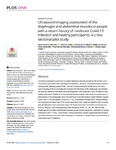Ultrasound imaging assessment of the diaphragm and abdominal muscles in people with a recent history of moderate Covid-19 infection and healthy participants: A cross-sectional pilot study

Use este enlace para citar
http://hdl.handle.net/2183/32919Colecciones
- Investigación (FEP) [514]
Metadatos
Mostrar el registro completo del ítemTítulo
Ultrasound imaging assessment of the diaphragm and abdominal muscles in people with a recent history of moderate Covid-19 infection and healthy participants: A cross-sectional pilot studyAutor(es)
Fecha
2023-02Cita bibliográfica
Romero-Morales C, Falla D, Pecos-Martı´n D, Garcı´a-Pe´rez-de-Sevilla G, Garcı´a-Bermejo P, Navarro-Flores E, et al. (2023) Ultrasound imaging assessment of the diaphragm and abdominal muscles in people with a recent history of moderate Covid-19 infection and healthy participants: A cross-sectional pilot study. PLoS ONE 18(2): e0281098. https://doi.org/10.1371/ journal.pone.0281098
Resumen
[Abstract] Coronavirus disease (Covid-19) is a highly infectious disease caused by the SARS-CoV-2 virus and is associated with a decrease of respiratory, physical, and sychological function, subsequently affecting quality of life. The aim of the present pilot study was to use ultrasound imaging (USI) to evaluate and compare the thickness of the diaphragm and abdominal muscles between individuals recently diagnosed with moderate Covid-19 infection and healthy individuals. Methods: A cross-sectional observational pilot study was performed. A total sample of 24 participants were recruited from a private medical center (Madrid, Spain): Covid-19 (n = 12) and healthy controls (n = 12). The external oblique (EO), internal oblique (IO), transversus abdominis (TrA), rectus abdominis (RA), interrecti distance (IRD) and diaphragm thickness were assessed using USI during inspiration, expiration and during contraction.
Results: USI measurements of the thickness of EO, IO, TrA, RA, IRD and the
diaphragm did not differ significantly between groups during inspiration, expiration or during
contraction (all P > 0.05). Conclusions: These preliminary results suggest that the morphology of the abdominal muscles and diaphragm is not altered in people with a recent history of moderate Covid-19 infection.
Palabras clave
COVID-19
Abdominal muscles
Thoracic diaphragm
Ultrasound imaging
Muscle contraction
Respiratory infections
Virus testing
Pilot studies
Abdominales
Diafragma torácico
Imagen por ultrasonidos
Contracción muscular
Infecciones respiratorias
Estudios piloto
Abdominal muscles
Thoracic diaphragm
Ultrasound imaging
Muscle contraction
Respiratory infections
Virus testing
Pilot studies
Abdominales
Diafragma torácico
Imagen por ultrasonidos
Contracción muscular
Infecciones respiratorias
Estudios piloto
Versión del editor
Derechos
Atribución 3.0 España






